Lesson 4 Overview
LESSON 4: POINT PATTERN ANALYSIS
Lesson 4 Overview
Introduction
In the previous lesson we saw how a spatial process can be described
in mathematical terms so that the patterns it is expected to produce
can be predicted. In this lesson we apply this knowledge to the
analysis of point patterns. Point pattern analysis is the application
in which these ideas are most thoroughly developed, so it is the best
place to learn about this approach.
Point pattern analysis has become an extremely important application
in recent years, particularly in crime analysis, in epidemiology, and
in facility location planning and management. Point pattern analysis
also goes all the way back to the very beginning of spatial analysis in
Dr. John Snow's work on the London cholera epidemic of 1854.
Learning Objectives
By the end of this lesson, you should be able to
- define point pattern analysis and list the conditions necessary for
it to work well
- explain how quadrat analysis of a point pattern is performed and
distinguish between quadrat census and a quadrat sampling methods
- discuss relevant factors in determining an appropriate quadrat size
for point pattern analysis
- describe in outline kernel density estimation and understand how it
transforms point data into a field representation
- describe distance-based measures of point patterns (mean nearest
neighbor distance and the G, F and K
functions)
- explain how distance-based methods of point pattern measurement are
derived from a distance matrix
- describe how the independent random process and expected values of
point pattern measures are used to evaluate point patterns, and to make
statistical statements about point patterns
- explain how Monte Carlo methods are used when analytical results for
spatial processes are difficult to derive
- justify the stochastic process approach to spatial statistical
analysis
- discuss the merits of point pattern analysis versus cluster
detection, and outline the issues involved in real world applications
of these methods
Reading Assignment
This week the reading is detailed, demanding, and long. I
therefore recommend that you start it as soon as possible, and also
that you read the material twice. First time through, you
should quickly skim the material to become familiar with the overall
plan. On the second pass, you should read more closely taking note of
the details. Whatever you do, don't leave the reading to the last
minute this week!
- Chapter 4, "Point Pattern Analysis," pages 77-114
- Chapter 5, Section 5.1, "Practical Point Pattern Analysis," pages
115-123
 You need only read the first section of Chapter 5 (noted below),
although I hope that you will find all of it useful as a guide to
current and future developments in point pattern analysis.
You need only read the first section of Chapter 5 (noted below),
although I hope that you will find all of it useful as a guide to
current and future developments in point pattern analysis.
After you've completed the reading, or at the very least skimmed the
material, get back online and supplement your reading from the
commentary material, then test your knowledge with the self-test
quizzes.
Lesson 4 Deliverables
This lesson is one week in length. The following items must be
completed by the end of the week. See the Calendar tab, above,
for the specific date.
- Complete the two self-test quizzes satisfactorily (you have an
unlimited number of attempts and must score 90% or more).
- Complete the Project 4 activities. This involves running and
interpretting point pattern analysis of some crime data for St Louis.
(The materials for Project 4 can be found under the Lessons tab, in the
Lesson 4 folder.)
- There is no specific activity in the quarter-long project this week,
as the core of this week's lesson will keep you busy enough. However,
don't forget that you have to submit a review of two other research
proposals next week—I will tell you which ones this week.
Questions?
If you have any questions now or at any point during this lesson,
please feel free to post them to the Lesson 4 thread on the
Lesson Content Discussion Forum .(That Discussion Forum can be
accessed at any time by clicking on the Communicate tab,
above, and then scrolling down to the Discussion Forums
section.)
Ready to continue? Click on the "Next" link, above, to continue with
this lesson.
LESSON 4: POINT PATTERN ANALYSIS
Commentary - Chapter 4, "Point Pattern Analysis"
Section 4.2, "Describing a point pattern," pages 79-81
It should be pointed out that the distinction between
first- and
second-order effects is a fine one. In fact, it is often
scale-dependent, and often an analytical convenience, rather than a
hard and fast distinction. This becomes particularly clear when you
realize that an effect that is first-order at one scale may become
second-order at a smaller scale (that is, when you 'zoom out').
The simplest example of this is when a (say) east-west steady rise in
land elevation viewed at a regional scale is first-order, but zooming
out to the continental scale, this trend becomes a more localized
topographic feature. This is yet another example of the
scale-dependence effects inherent in spatial analysis and noted in
Lesson 1.
Section 4.3, "Density-based point pattern measures," pages 81-88
It is worth emphasizing the point that
quadrats need not be square, although it is rare for them not to be.
With regard to
kernel density estimation (KDE) it is worth pointing out the
strongly scale-dependent nature of this analysis method. This becomes
apparent when we view the effect of varying the KDE bandwidth on the
estimated
event density map in the following sequence of maps, all generated
from the same
pattern of homicide events in St. Louis, Missouri downtown in 1982.
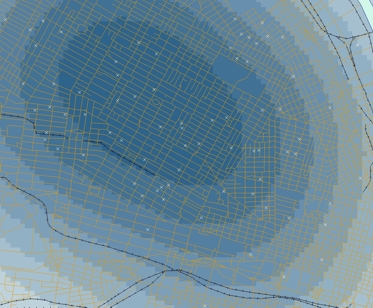
Using a large KDE bandwidth results in a very
generalized impression of the event density.
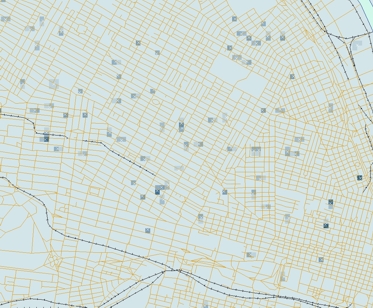
The map generated using a small KDE bandwidth is also
problematic, as it focuses too much on individual events.
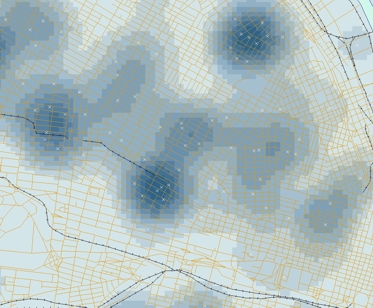
An intermediate choice of bandwidth results in a more
satisfactory map that enables distinct regions of high density of
events (clusters) to be identified.
Section 4.4, "Distance-based point pattern measures," pages 88-95
It may be helpful to briefly distinguish the four major
distance methods discussed here:
- Mean
nearest neighbor distance is exactly what the name says!
-
G function is the cumulative frequency distribution of the
nearest neighbor distance. It gives the probability for a specified
distance, that the nearest neighbor distance to another event in the
pattern will be less than the specified distance.
-
F function is the cumulative frequency distribution of the
distance to the nearest event in the pattern from random locations
not in the pattern.
-
K function is based on all inter-event distances, not
simply nearest neighbor distances. Interpretation of the K
function is tricky for the raw figures and makes more sense when
statistical analysis is carried out as discussed in a later section.
It is useful to see these measures as forming a progression from
least to most informative (with an accompanying rise in complexity).
Section 4.5, "Assessing point patterns statistically," pages 95-108
The measures discussed in the preceding two sections can all be
tested statistically for deviations from the expected values associated
with a random point
process. In fact deviations from any well defined process can be
tested, although the mathematics required becomes more complex.
This section simply outlines how each of the measures described in
previous sections may be tested statistically. The most complex of
these is the K function, where the additional concept on an
L function is introduced to make it easier to detect large
deviations from a random pattern.
More important, in practical terms is the
Monte Carlo procedure discussed on pages 104-108. Monte
Carlo methods are common in statistics generally, but are particularly
useful in spatial analysis when mathematical derivation of the expected
values of a pattern measure can be very difficult. Instead of trying to
derive analytical results, we simply resort to the computer's ability
to randomly generate many patterns according to the process description
we have in mind, and then compare our observed result to the simulated
distribution of results. This approach is explored in more detail in
the project for this lesson.

Ready? Take the Chapter 4 Quiz to check your knowledge! Click on the
"Next" link, above, to access the self-test quiz for Chapter 4. You
have an unlimited number of attempts and must score 90% or more.
Ready to continue? Click on the "Next" link, above, to begin the
Chapter 4 Quiz.
LESSON 4: POINT PATTERN ANALYSIS
Commentary - Chapter 5, Section 5.1, "Point Pattern Analysis Versus
Cluster Detection"
The key issue here is that classic
point pattern analysis allows us to say that a
pattern is '
evenly-spaced' or '
clustered' relative to some null
spatial process (usually the independent random process), but it
does not allow us to say where the pattern is clustered. This
is important in most real world applications. A criminal investigator
takes it for granted that crime is more common at particular
'hotspots', i.e., that the pattern is clustered, so statistical
confirmation of this assumption might be nice, but it is not
particularly useful. However, an indication of where the crime
hotspots are located is definitely useful.
The problem is that detecting clusters in the presence of background
variation in the affected population is very difficult. This is
especially so for rare
events. You can get some idea of the degree of difficulty from the
description of the Geographical Analysis Machine (GAM) on pages
119-122. Although GAM has not been widely adopted by epidemiologists,
the approach suggested by it was ground-breaking and other more recent
tools use very similar methods. (See the optional 'Try This' box below
for more on this.)
The basic idea is very simple: repeatedly examine circular areas on
the map and compare the observed number of events of interest to the
number that would be expected under some
null hypothesis (usually spatial randomness). Tag all those circles
that are statistically unusual. That's it!
Three things make this conceptually simple procedure tricky.
- First, is the statistical theory associated with determining an
expected number of events�perhaps dependent on a number of spatially
varying covariates of the events of interest, such as populations in
different age subgroups. Thus, for a disease (say) associated with
older members of the population, we would naturally expect to see more
cases of the disease in places where more older people live. This has
to be accounted for in determination of the number of events expected.
- Second, there are some conceptual difficulties in carrying out
multiple
statistical significance tests on a series of (usually) overlapping
circles. The rather sloppy statistical theory in the original
presentation of the GAM goes a long way to explaining the reluctance of
statistical epidemiologists to adopt the tool, even though more recent
tools are rather similar.
- Third, is the enormous amount of computation required for exhaustive
searching for clusters. This is especially so if stringent levels of
statistical significance are required, since many more
Monte Carlo simulation runs are then required.

If you are interested, take a look at
the SatSCAN website. SatSCAN is a tool developed by the
Biometry Research Group of the National Cancer Institute in the United
States. SatSCAN works in a very similar way to the original GAM tool,
but has wider acceptance among epidemiological researchers. You can
download a free copy of the software and try it on on some sample data.

Ready? Take the Section 5.1 Quiz to check your knowledge! Click on
the "Next" link, above, to access the self-test quiz for Section 5.1.
You have an unlimited number of attempts and must score 90% or more.
Ready to continue? Click on the "Next" link, above, to begin the
Section 5.1 Quiz.
LESSON 4: POINT PATTERN ANALYSIS
Final Activities for Lesson 4
Now that you've completed the readings and self-test quizzes for this
lesson, it is time to apply what you've learned!
 The following links will open in a new browser window.
The following links will open in a new browser window.
- Complete Project 4, in which we will analyze crime
data for St Louis, in order to demonstrate some of the point pattern
analysis methods that have been discussed in this week's lesson. (When
you are done reviewing this Web page, click on the "Next" link, above,
to begin Project 4. The materials for Project 4 can also be found under
the Lessons tab, in the Lesson 4 folder.)
- Continue the Quarter-long Project by reviewing the
Week 4 directions. ( This link opens in a new window - The materials
for the Quarter-long Project can be also be found under the Lessons
tab.)
Ready to continue? Click on the "Next" link, above, to begin Project
4.
PROJECT 4: POINT PATTERN ANALYSIS
Overview
Background
In this week's project you will use some of the point pattern
analysis tools available in ArcGIS together with one we've made
specially for this course to investigate a point pattern of crime
events in St. Louis.
Project Resources
The ArcMap template file and data files you need for Project 4 are
available here for download. If you have any difficulty downloading
these files, please contact me.
-
PtPatternAnalysis_v9.2.mxt is an ArcMap template file with
additional custom functionality to support quadrat analysis. (That file
is 783 Kb and will take approximately 2 minutes to download over a 56
Kbps modem.) Many, many thanks to
Jim Detwiler for programming this file!
- project4_ptData.zip
is a zip file that contains two shape files: gunHomicide.shp
records the locations of homicides in St. Louis, Missouri, in 1982; and
attemptedStreetRobbery.shp, which records the location of
incidents of attempted 'non-residential burglary' over the same period.
(That file is 14 Kb and should be quick to download even over a 56 Kbps
modem. Once you have downloaded the file, double-click on the
project4_ptData.zip file to launch WinZip, PKZip, 7-Zip, or another
file compression utility. Follow your software's prompts to decompress
the file.)
- project4_data.zip
is a zipped version of an ArcGIS geodatabase file StLouisCrime.mdb
, with layers of background topography, principally the street network,
for St. Louis, Missouri. This serves no actual purpose in the analysis
as such, but gives some context for the exercise, and may help in your
discussions of results. (That file is 1.9 Mb and will take around 5
minutes to download over a 56 Kbps modem. Once you have downloaded the
file, double-click on the project4_data.zip file to launch
WinZip, PKZip, 7-Zip, or another file compression utility. Follow your
software's prompts to decompress the file.)
Open a new ArcMap map from the .mxt template file. Do this
either:
- By double-clicking on PtPatternAnalysis_v9.mxt in the
explorer, or
- From ArcMap by selecting File - New... and navigating to
the PtPatternAnalysis.mxt template, or
- From the ArcMap start up dialog, by selecting the Start Using
ArcMap with a Template option.
You should immediately set the File - Map Properties... - Data
Source Options... to Store Relative Path Names, and save
the new project (even with no data) to a new .mxd file.
Once you've done that, load in the shape files from
project4_Ptdata.zip along with the background layers in the
StLouisCrime.mdb file. .
Summary of Project 4 Deliverables
For Project 4, the items you are required to submit are as follows:
 Create and insert a map showing standard deviational
ellipses for the two crime patterns and commentary on the relative
locations of the two patterns.
Create and insert a map showing standard deviational
ellipses for the two crime patterns and commentary on the relative
locations of the two patterns. Calculate nearest neighbor distance statistics for both
crime patterns and comment on these results.
Calculate nearest neighbor distance statistics for both
crime patterns and comment on these results. Create and insert maps of quadrat analyses of the two crime
patterns, along with commentary on each, and details of the analysis
results in each case. You have to choose the quadrat size and analysis
method (census- or sample-based) and should provide some explanation of
your choices.
Create and insert maps of quadrat analyses of the two crime
patterns, along with commentary on each, and details of the analysis
results in each case. You have to choose the quadrat size and analysis
method (census- or sample-based) and should provide some explanation of
your choices. Create density maps of the gunHomicide and
attemptedStreetRobbery data. Insert the maps into your write-up
along with commentary explaining your choice of parameters,
particularly the bandwidth.
Create density maps of the gunHomicide and
attemptedStreetRobbery data. Insert the maps into your write-up
along with commentary explaining your choice of parameters,
particularly the bandwidth. Finally, comment on the study area in all these examples:
it has effectively been set for you by the dataset. Do you think more
extensive data would lead to different conclusions? How would the
results be affected?
Finally, comment on the study area in all these examples:
it has effectively been set for you by the dataset. Do you think more
extensive data would lead to different conclusions? How would the
results be affected?
Questions?
If you have any questions now or at any point during this project,
please feel free to post them to the Project 4 thread on the
Project Discussion Forum. (That Discussion Forum can be accessed at
any time by clicking on the In Touch tab, above, and then
scrolling down to the Discussion Forums section.)
Ready to continue? Click on the "Next" link, above, to continue with
this project.
PROJECT 4: POINT PATTERN ANALYSIS
Standard Deviation Ellipses for the Crime Patterns
Before conducting any analysis it is sensible to get an overall feel
for the two crime patterns. The ArcGIS Toolbox provides some simple
tools for this including standard deviation ellipses. To open the
toolbox, click on the  button in the main application toolbar. In the hierarchical
list of toolboxes that appears, you will find the standard deviation
ellipse tool in the Spatial Statistics Tools - Measuring Geographic
Distributions toolbox. Operation of the tool is self-explanatory, so
I'll leave it to you to figure things out.
button in the main application toolbar. In the hierarchical
list of toolboxes that appears, you will find the standard deviation
ellipse tool in the Spatial Statistics Tools - Measuring Geographic
Distributions toolbox. Operation of the tool is self-explanatory, so
I'll leave it to you to figure things out.
 Create a map showing standard deviational ellipses for the
two crime patterns and commentary on the relative locations of the two
patterns.
Create a map showing standard deviational ellipses for the
two crime patterns and commentary on the relative locations of the two
patterns.
Ready to continue? Click on the "Next" link, above, to continue with
this project.
PROJECT 4: POINT PATTERN ANALYSIS
Mean Nearest Neighbor Distance Analysis for the Crime Patterns
Next conduct mean nearest neighbor distance analysis of the crime
patterns. You will find the required tool in the Spatial Statistics
Toolbox in the 'Analyzing Patterns' subset. Operation of this tool is
self-explanatory, so I'll allow you to figure it out for yourself.
 Calculate nearest neighbor distance statistics for both
crime patterns and report and comment on the results.
Calculate nearest neighbor distance statistics for both
crime patterns and report and comment on the results.
Ready to continue? Click on the "Next" link, above, to continue with
this project.
PROJECT 4: POINT PATTERN ANALYSIS
Familiarization with the Quadrat Analysis Tool
As part of this project, a quadrat analysis tool has been developed
by
Jim Detwiler. This page explains its operation.
The quadrat analysis tool is available in any map file created from
the PtPatternAnalysis_v9.mxt template and appears as a
toolbar:

The Point Pattern Analysis toolbar
If the toolbar is not available, right-click on the ArcMap program
window and select it from the drop-down menu:

The right-click menu that allows you to enable Point
Pattern Analysis
Defining the study area
- To define a study area for analysis click on the New Rectangle
button then mouse-drag a rectangle across from one corner to the
diagonally opposite corner of the rectangular study area you wish to
define. This creates a graphic object that is currently selected.
- To define this as the study area for either census or grid-based
quadrat analysis click on Census - Create Grid or on
Sampling - Define Study Area. What happens next is explained in the
next two sections.
 If you want to define a quadrat analysis with precise dimensions, then
before clicking on the Create Grid or Define Study Area
menu items, you should right-click on the rectangle, and select
Properties - Size and Position and define the width and height you
want. You can also define how the rectangle is drawn. Making it
transparent will make it easier to position it precisely where you want
by dragging.
If you want to define a quadrat analysis with precise dimensions, then
before clicking on the Create Grid or Define Study Area
menu items, you should right-click on the rectangle, and select
Properties - Size and Position and define the width and height you
want. You can also define how the rectangle is drawn. Making it
transparent will make it easier to position it precisely where you want
by dragging.
Defining a grid for census-based analysis and running the analysis
The Census - Create Grid option asks you to define the
parameters for a regular rectangular grid inside the study area
rectangle just defined. This is done in terms of the required numbers
of rows and columns of (rectangular) quadrats.
Once you have defined the number of rows and columns, a new shapefile
will be created and added to the map.
- To use the new shapefile for quadrat analysis, click Census -
Run Analysis. In the dialog that appears specify the point layer
containing the pattern to analyze, specify whether or not to use an
attribute of each point as an event count, and specify the shapefile
containing the census quadrats to use. Then click on Calculate
Stats to run the analysis.
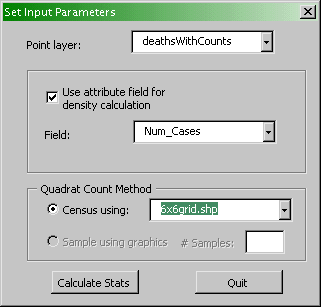
Use this dialog to define parameters for the quadrat
analysis.
- When the analysis is complete, the following results window will
appear:

Results from quadrat analysis. These are formatted in
a similar way to Table 4.3 on page 99 of the course text.
- You can save the results to a text file in a spreadsheet readable
format by clicking the Export button.
 The analysis adds a field to the census grid shapefile named 'K' which,
for each quadrat records how many events occurred in that quadrat. You
may find it helpful in understanding the method to color the layer
using this attribute.
The analysis adds a field to the census grid shapefile named 'K' which,
for each quadrat records how many events occurred in that quadrat. You
may find it helpful in understanding the method to color the layer
using this attribute.
Defining a quadrat for sample-based analysis
- For sample-based analysis, once you have defined a study region with
the New Rectangle tool, by clicking on Sampling - Define
Study Area, you should again click on New Rectangle and
draw a new rectangle, then click on Sampling - Define Quadrat
to specify that this is the quadrat shape required.
- Once both shapes are defined, click on Sampling - Run Analysis
to calculate the results as for a census-based analysis.
- When you have completed sample-based analysis, you can remove all
the graphic objects it creates using the Remove Count Labels
and Remove Quadrats buttons. Note that the Remove Quadrats
button will leave both the study area rectangle and one quadrat intact,
in case you want to repeat the analysis. You should select and delete
these by hand if you want a 'clean' display.
 You can make non-rectangular quadrats for sample-based analysis using
the ArcMap drawing tools. However, the Remove Quadrats button
will not work properly on them, and you will have to clean up by hand.
You can make non-rectangular quadrats for sample-based analysis using
the ArcMap drawing tools. However, the Remove Quadrats button
will not work properly on them, and you will have to clean up by hand.
Exporting the results to a text file and determining a p
value
- Click on Export in the Quadrat Count Statistics
dialog to create a tab-separated text file summarizing the analysis
results.
- Read the tab-separated text file with a spreadsheet program to
determine the p value associated with the analysis. In
Openoffice.org Calc or Microsoft Excel the function required to
calculate this is CHIDIST.
 You can also use a spreadsheet program to plot a histogram of the
analysis results, which you may also find helpful.
You can also use a spreadsheet program to plot a histogram of the
analysis results, which you may also find helpful.
Ready to continue? Click on the "Next" link, above, to continue with
this project.
PROJECT 4: POINT PATTERN ANALYSIS
Quadrat Analysis of the Two Crime Patterns
Perform quadrat analyses on each of the two crime patterns. You
should base your choices of study area, quadrat size and numbers of
quadrats as well as the method (census- or sample-based) on the
previous descriptive analyses and also on your reading of this week's
lesson and its support materials. Note that it is not necessary to
define a study region that includes all the events in each case. You
may wish to consider the advantages (or not) of defining the same study
area for each pattern.
 Create maps of quadrat analyses of the two crime patterns,
along with commentary on each, and details of the analysis results in
each case. You have to choose the quadrat size and analysis method
(census- or sample-based) and should provide some explanation of your
choices.
Create maps of quadrat analyses of the two crime patterns,
along with commentary on each, and details of the analysis results in
each case. You have to choose the quadrat size and analysis method
(census- or sample-based) and should provide some explanation of your
choices.
Ready to continue? Click on the "Next" link, above, to continue with
this project.
PROJECT 4: POINT PATTERN ANALYSIS
Kernel Density Analysis
In this part of the project, you use built-in ArcMap Spatial Analyst
functionality to help understand the crime data. Two maps and
accompanying commentary are required. Both are made using the
Spatial Analyst - Density... tool.
- First, open the Spatial Analyst - Density... tool. You will
see the following dialog box:
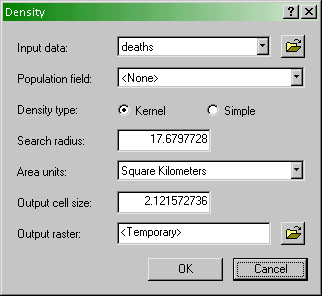
The density estimation dialog box. Specify parameters
for kernel density estimation here (see text).
- Specify the following parameters:
- Input data - the point pattern data set
- Population field - the attribute that includes a count of
the number of events occurring at one location.
- Density type - Kernel or Simple, as
discussed in the text. In this project you should select Kernel
.
- Search radius - the kernel bandwidth.
- Area units - the units that will be used in the density
estimate calculation.
- Output cell size - the resolution of the grid across which
density estimates will be made.
- Output raster - a file name for saving the analysis result
permanently.
- Use this dialog for the analyses outlined below.
 Create density maps of the gunHomicide and
attemptedStreetRobbery data. Place the maps in your write-up along
with commentary explaining your choice of parameters, particularly the
bandwidth.
Create density maps of the gunHomicide and
attemptedStreetRobbery data. Place the maps in your write-up along
with commentary explaining your choice of parameters, particularly the
bandwidth. Finally, comment on the study area in all these examples:
it has effectively been set for you by the dataset. Do you think more
extensive data would lead to different conclusions? How would the
results be affected.
Finally, comment on the study area in all these examples:
it has effectively been set for you by the dataset. Do you think more
extensive data would lead to different conclusions? How would the
results be affected.
Ready to continue? Click on the "Next" link, above, to continue with
this project.
End of Project 4 - Remember, if you have any
questions, post them to the appropriate Discussion Forum.
QUARTER-LONG PROJECT
Week 4: Beginning the Peer Review Process
There is no specific deliverable for this week, however you should
use this week to begin the peer review process for the preliminary
proposals. Early this week I will send an email letting you know which
two other student's proposals you have been assigned to review. Begin
by looking at the two proposals you have been assigned to review as
posted on the 'Project Initial Proposal discussion board' (you can get
to this by clicking on 'Previous' above). Then, simply post your
comments as a response to the assigned project proposal message. Your
peer reviews are due by the end of Week 5. (Although you are welcome to
post them at any point between now and then.)
You should consider the following aspects in writing comments for the
authors of the proposals:
- Are the goals reasonable and achievable? It is a common mistake to
aim too high and attempt to do too much. Suggest possible amendments to
the proposals' aims that might make them more achievable in the time
frame.
- Are the data adequate for the task proposed? Do you foresee problems
in obtaining or organizing the data? Suggest how these problems could
be avoided.
- Are the proposed analysis methods appropriate? Suggest alternative
methods, or enhancements to the proposed methods that would also help.
- Provide any additional input that you feel is appropriate. This
could include suggestions for additional outputs (e.g., maps) not
specifically mentioned by the author, or suggestions as to further data
sources, relevant things to read, relevant other examples to look at,
and so on.
Remember... you will be receiving two reviews from other students of
your own proposal, so you should include the types of useful feedback
that you would like to see in those commentaries. Criticism is fine,
provided that it includes constructive inputs and suggestions. If
something is wrong, how can it be fixed?
Meanwhile, I will be reviewing the preliminary proposals,
and providing each of you with feedback and suggestions. I will aim to
complete my reviews and mail them to you this week.
Questions?
If you have any questions now or at any point during this project,
please feel free to post them to the Quarter-long Project
Discussion Forum. (That Discussion Forum can be accessed at any
time by clicking on the In Touch tab, above, and then
scrolling down to the Discussion Forums section.)
That's it for the quarter-long project this week!
 You need only read the first section of Chapter 5 (noted below),
although I hope that you will find all of it useful as a guide to
current and future developments in point pattern analysis.
You need only read the first section of Chapter 5 (noted below),
although I hope that you will find all of it useful as a guide to
current and future developments in point pattern analysis.





